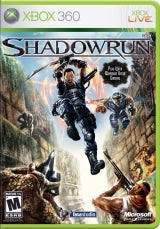GameSpy: During testing, have you found that certain strategies, races, or weapons work particularly well for these maps?
Mitch Gitelman: Maelstrom's pretty chaotic. I use Enhanced Vision a lot on that one along with Smartlink since it's fairly contained on the interior and I don't want to murder my teammates.
For Temple Grounds, I consider it is a glide/teleport combo dream map. In general, I like to play trolls when I'm on defense and elf when I'm on offense.
Video Game Cartography 101
GameSpy: What aspects of Shadowrun's gameplay make it unique and must be taken into account when designing multiplayer maps?
Mitch Gitelman: Wow, big question. When we design a Shadowrun map, we need to figure in the ability to glide, teleport, boost speed, set up a defense, and more when thinking about what's fun. Using strangle crystals to close off a doorway is cool but when you can teleport through a wall, does it still have value? All of these things need to be considered.
Then there're the technical issues. Most next-gen FPS games are either indoor hallway shooters or outdoor games to get the most graphical fidelity. You have to make those engine decisions when designing your game. Shadowrun takes place with interiors, exteriors, hallways, vistas, etc. You can glide over the battlefield and you can teleport from tight interiors to broad exteriors instantly. In order to keep our graphical detail and framerate high, we had to design our maps with that in mind. It was a major challenge that required our artists, designers and programmers to work tightly along with our producers to balance it all out. Not for the squeamish.
GameSpy: Designing a map for a multiplayer game requires that both sides have a balanced layout to work with. How is this handled with asymmetrical maps?
Mitch Gitelman: Our asymmetrical maps are offense/defense Raid maps and are made to present interesting challenges and gameplay from each side. Our Extraction maps are more symmetrical to balance the dual drop point gameplay.GameSpy: What's the role of the Ziggurat in the Shadowrun universe and in this version of the game? And are there smaller variations of these maps on the final version of Shadowrun?
Mitch Gitelman: The Zig doesn't have a role in the broader Shadowrun universe. It's part of one story in one part of the world, just like an RPG module for the paper and pencil game.GameSpy: Where would you rank these maps in relation to the other maps included in the final version of Shadowrun? What makes them unique?
And yes, three of the maps have smaller versions for sessions with less players in them.
Mitch Gitelman: Maelstrom is quite different than any other map in Shadowrun. I like to play it as a change of pace. Temple Grounds is one of our best maps for teamwork and visual cohesiveness and ranks near the top of the list for me.GameSpy: People have only had the chance to play the maps on the beta, how do these Ziggurat maps vary from those on the beta?
Mitch Gitelman: Oh man, they're dramatically different. You may not feel like you're playing the same game. Temple is a little like Powerstation in that it's offense/defense and there's an interior and exterior. But Powerstation is a training map designed to get you used to our new gameplay. It's simple by comparison. Maelstrom is an Extraction game where both teams can move the artifact so it's very fast paced and relatively symmetrical like the RNA Lobby map. Again, Lobby is very simple by comparison. It was also designed as a starter map to help you learn the gametype. The final game's maps are well beyond anything we put in the beta, graphically and gameplay-wise.GameSpy: Thanks for your time, Mitch!





